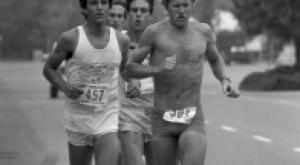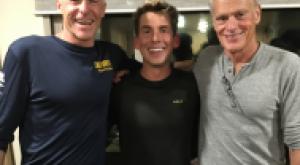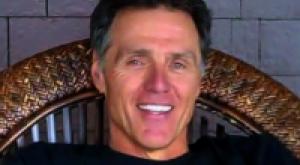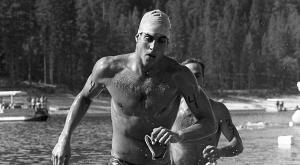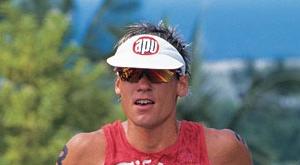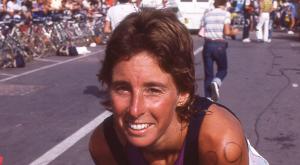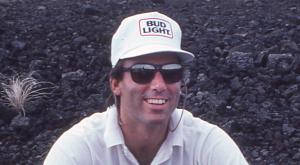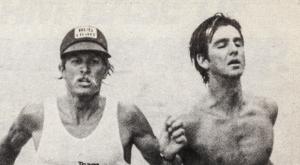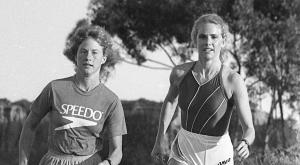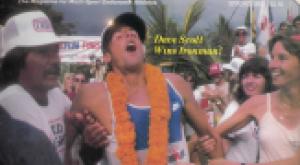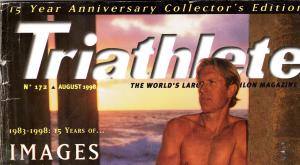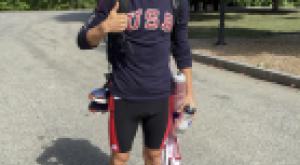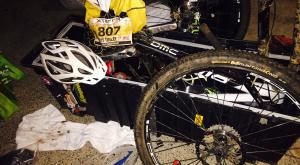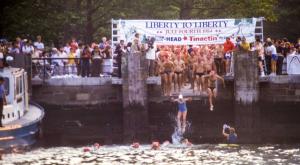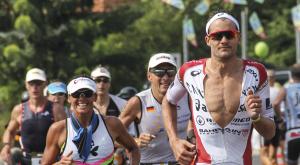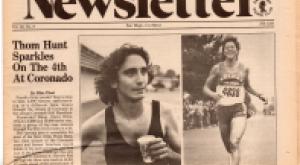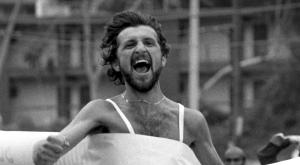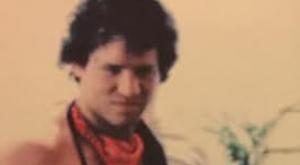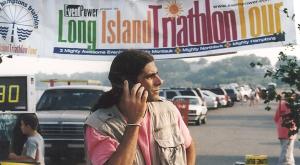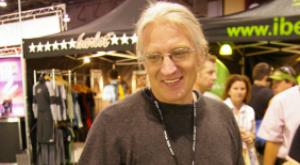This is the kind of story we tell each other over a beer. It’s a triathlon classic from the wooly early days of the sport, when the world was just waking up to the notion of triathlon, and even folks in the business were learning as they went. It was on-the-job training for everyone,...
Read MoreYou are here
Notebook
Here is some of the latest news in the world of triathlons and triathlon history.
Kona Notes – The Real Kona Story

Susan Shaw with Cathy Plant at the Kona Inn, on the Tuesday night after the race.
Next time you're in Kona for the Ironman, be sure to dine at least once at the Kona Inn, right in the thick of things on the Makai (ocean) side of Alii Drive. Have the calamari sandwich, and be sure to sit in Susan Shaw's section. Susan, who is 69 years old and acts 35, has been at the Kona Inn since forever, and can tell you stories about every Ironman since the first race on the Big Island in 1981, including a wonderful first-hand account of the last two folks to finish that year: Teiichiro Tsutsumi, in 25:44:02 (yes, 25 hours) and Walt Stack, in 26:20:25. Relations between the locals and the triathletes were still getting worked out back then, but to hear Susan talk about a crew of her friends acting as human bumper rails for the staggering last-finishers is a story you just have the hear for yourself.
Kona Notes – Carfrae’s Marathon is Historic. Again.
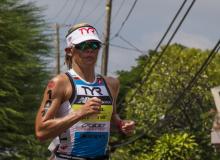
Mirinda Carfrae on her way to second marathon course record and a second straight victory at the Ironman World Championships in Kona. Photo courtesy of Paul Phillips /Competitive Image
It's hard to make meaningful cross-sport performance comparisons, but I happened to notice on my phone the results of the Chicago Marathon on Oct. 11, about the time that Australia's Mirinda Carfrae was gobbling up Daniela Ryf, on the Queen K at the Ironman in Kona, on her way to a record 2:50:26 and a second straight Ironman/Kona victory.
The top three men in Chicago, all from Kenya, all ran sub-2:05 marathons: Eliud Kipchoge. 2:04:11; Sammy Kitwara, 2:04:28; Dickson Chumba, 2:04:32. The top woman in Chicago, Rita Jeptoo, also from Kenya, finished 2:24:35, more than a minute faster than Mare Dibaba of Ethiopia (2:25:37) in second, and Florence Kiplagat of Kenya (2:25:57) in third.
I had already watched the men's winner in Kona, Sebastian Keinle, from Germany, go by me just before the right turn from Kuakini Highway to Hualalai Road on his way to the finish line. Earlier in the race, Keinle had run the roughly 9-mile Alii Drive loop in around approximately 55 minutes, a little over a six-minute-per-pace. But by the end, the six-minutes miles were long gone; Keinle had slowed to the point where several age groupers, with 25 miles still to go, were able to hold his pace and savor the experience of having run with the winner of the ironman, if only for a moment or two.
Here's what I thought was interesting: Keinle's winning marathon time was 2:54:56, or 52:45 minutes slower than Kipchoge's 2:04:11 in Chicago. The fastest marathon of the day among the men in Kona, a strong 2:47:46 by Keinle's countryman Jan Frodeno, was still 45:35 off Kipchoge's pace. In contrast, Carfrae's 2:50:26 gave up just 25:21 to Jeptoo's 2:24:35. And Jeptoo is no slouch; she hasn't lost a major marathon in two years, and is the current course record holder at Boston.
Again, to be clear, one race is not statistically relevant. But in retrospect, while Keinle's race this year at Ironman was heroic – he hammered to a big lead off the bike, then crushed the first half of the marathon, challenging the rest of the field to chase him down – Carfae's performance was nothing short of historic. She is out-performing at every level. How long her reign will last is anyone's guess, but at this point in her career she is climbing rapidly toward heights scaled before her by Ironman legends and multiple Kona winners Dave Scott, Mark Allen, Paula Newby-Fraser and Natasha Badmann.
USAT Hall of Fame Inducts Five in Class of 2014
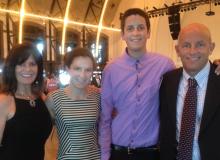
Triathlon Hall of Famer Mike Pigg and family at the Induction Ceremony in Chicago in June.
An Historian's Dilemma
"An event enters 'history' when it is recorded. But there may be multiple, and competing histories; as there are multiple, and competing, eyewitness accounts." – Joyce Carol Oates
John and Judy Come Out Swinging
FIVE INDIVIDUALS WERE INDUCTED into the USAT Triathlon Hall of Fame at a ceremony on June 26 at Navy Pier in Chicago: Pro triathlon great Mike Pigg; age-group legend Sister Madonna Buder, the wonderfully eccentric Tom Warren, winner of the 1979 "Iron Man"; and John and Judy Collins, who were recognized by the Hall as co-founders of the Ironman, and who came out swinging in their acceptance speeches against any past, present or future telling of the Ironman Creation story but the official Collins-approved version.
In theory it is a hard point to argue. The Collins' were there, after all. Their place among the Founding Mothers and Fathers of Triathlon is irrefutable. But the story is nearly four decades old, and absolute authenticity is a slippery thing to grasp for any period of time, especially after multiple retellings. For those of us who hold and tell the history of the sport, the Collins' closing comments at the celebration raised significant questions for triathlon historians: Is the past retold more accurately, or less so, over time? And is it the details that matter most, or the historical impact? Do we settle for the story or revel in the myth?
McGillivray Introduces Mike Pigg
History was not the issue for Mike Pigg, whose induction into the Hall was an acknowledgement that nice guys sometime do finish first. In his acceptance speech, Pigg was as charmingly down to earth as he was during his competitive prime, eloquent in his lack of pretension. He gave special thanks to his wife, Marci, and his former business manager and now fellow Hall-of-Famer, Dave McGillivray, who flew into Chicago from Boston for the sole purpose of introducing his close friend and former client. Addressing his 16-old twin children, Chloe and Christian, from the podium, Pigg, using himself as the best possible example, encouraged them to 'follow your dreams, follow your hearts." Known and widely recognized for his fearless, go-for-broke racing style and for being the man who shattered the dominance of the Big Four back in the mid-1980's and early 90's, Mike Pigg is also much loved – for being... well, Mike Pigg. If that is not a way to teach your children well, then such a thing does not exist. Link HERE to Scott Tinley's recollection of the Pigg Man.
Sister Buder, Amazed and Amazing
As for Sister Buder, the honor apparently came as a genuine surprise. She seemed flabbergasted to be on stage, yet at the same time expressed a charming sense of entitlement, musing to the crowd that, upon reflection, she had, after all, been breaking age barriers in the sport for early 40 years. Neither the audience nor USAT needed to be convinced, although Buder was obviously still trying to get her arms around it. The fact is, Buder is a triathlon icon. She has been a PR bonanza for the sport since her early days in the 1980's with the Bud Light U.S. Triathlon Series, and the number of older athletes she has inspired probably cannot be counted. In her long career she has completed hundreds of triathlons and dozens of Ironman-distance events. She is the sport's Patron Saint of Back-of-the-Packers, a throwback to the early days when eccentricity ruled over physical prowess. True to triathlon form, Buder's acceptance speech focused not on teary-eyed nostalgia, but rather on her recent recovery from a broken hip and subsequent attempt to qualify, at age 83, for the 2014 Ironman in Kona. The power of prayer came up, of course. And she did cry a bit – at the end – when she called the people in the sport her family. It was corny, genuine, touching and absolutely perfect.
Tom Warren, Aging But Ageless
Warren, who doesn't like to fly and did not attend the ceremony, was recognized for winning Ironman #2 in 1979, but mostly for being in the right place at the right time, then knowing what to do with the opportunity. Put any four 60-year-old triathletes from San Diego in the same room and there will be Tom Warren stories bouncing off the walls within minutes. Warren's biker bar/tavern "Tugs" is a must-see stop on any magical mystery tour of the sport (the actual building is long gone, but the site still resonates), and ghostly shades from his Swim-Run-Swim biathlon still haunt the sands of San Diego's Pacific Beach. The USAT Hall of Fame would not be complete without Tom Warren; his touching appearance on a taped acceptance speech was likely the first time most of the younger members of the audience had ever laid eyes on him. That is regrettable; those of us who knew him in his prime knew an athlete, a philosopher, an individualist whose unique approach to life and competition helped shaped the first decade of what Time magazine once called a "cobbled-up sport." If not exactly a Founding Father, Warren was, at the very least, one of our most prominent cobblers. Follow link HERE to read an account of Warren's 1978 victory from Mike Plant's book, Iron Will
John and Judy Collins – A Quixotic Quest
For the Collins', who were introduced by their children, the podium became a something of a pulpit. Both offered passionate claims that the real story of How the Ironman Came To Be has never been accurately told, and that Judy's role has been appreciably and consistently understated.
In the sense that the Ironman concept unquestionably originated in the Collins household, it's hard to argue the veracity of their claim. It is their story, after all. And if John says Judy deserves more credit, whose place is it to contradict? Yet for years, John Collins praised this correspondent (and perhaps others) for doing the necessary homework, for cutting through the early myth and telling the story as it truly occurred. His current claim that "No one seems interested, really, in how it happened, where it happened and where it came from," is an unfortunate generalization.
Historically speaking, the Collins' are on a Quixotic quest. Despite their passion, they will never set the story "straight." The telling will never be "right," simply because the memories of everyone involved, including the Collins', are 37 years old. And even if a completely accurate version did exist in a vault somewhere, it would be unlikely to resonate because the Iron-myth that the couple is battling against so desperately – that of a drunken, muscle-bound barroom challenge -- is so bloody compelling.
Thomas Mann said, "For the myth is the foundation of life." If the Ironman is still around in 50 years, the story of the First Race will likely be better than ever, and even farther from the truth, no matter how hard the Collins' or anyone else try to make it otherwise. History is programmed to march toward exaggeration. The men will be bigger, stronger and drunker, the women will look like characters in a Frank Frazetta painting, and there will be dead bodies on the floor. It won't be anywhere near what it really was, but it will be a helluva lot more fun.
In any case, as of 1985, Chapter 4 of my book "Iron Will – Triathlon's Toughest Challenge" – was the closest thing to an accurate, carefully researched narrative of the how the first Ironman came to be. The chapter may not track with the current telling of the tale, but at the time, it was close, at least. The hours of interview tapes with the principal characters, including former Commander Collins, still exist. Hopefully, it's still good reading. See PDF link below.
Paratriathletes Walked A Hard Road To Shine on World Stage
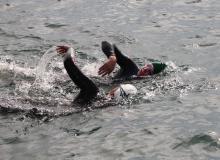
Blind paratriathlete Patricia Walsh, top, from Austin, Texas swims in perfect syncronicity with her guide at the ITU World Triathlon in Chcago on June 28, 2014. Walsh won the PT5 division and is a top contender for a spot on the 2016 U.S. Paratriathlon team in Rio. -- Mike Plant photo
With Paratriathlon set to debut at the Paralympics in Brazil in 2016, the sport has claimed a level of legitimacy and popularity not even remotely anticipated two decades ago. At the ITU World Triathlon event in Chicago on June 28, an international field of 60 or so elite paratriathletes in five categories opened the weekend's competition with an impressive show of strength, talent and unflinching support by the able-bodied triathlon community.
All this is as it should be, of course. But it was not always so. In many cases, disabled athletes had to fight their way into races, overcoming resistance that today seems pathetically contrived: insurance issues, dangers to other athletes, entrenched skepticism and, at times, outright hostility. In some cases, the battle on the race course was literally joined between wary race directors and activist athletes.
One early disabled triathlete, Jon Franks, was an outspoken pioneer, a militant activist whose manner was controversial and whose methods even his supporters often questioned. Did Franks help or hurt the cause? Would any of the paratriathletes racing in Chicago in June even recognize his name? Read the profile in the accompanying piece (PDF link below), "Angry Man In An Uneasy Chair" in the Oct.27, 1989 issue of The Plant Report . We've included the entire issue of that publication; it's an interesting look back at what blogs were like before there were such things as...blogs. – MP
JORGENSEN MAKING HISTORY AT ITU WORLD CUP RACES
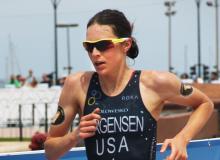
American pro Gwen Jorgensen is still improving as a complete triathlete, but her running prowess is giving her the leading edge on the international World Cup Circuit. Mike Plant photo
If prehistory refers to the time before written records, what do you call something you observe in the present time that you believe with reasonable certainty will be of historical value in the future?
I suppose "history in the making" will have to suffice. I knew I'd witnessed an historic event at the Ironman in 1988 when Paula Newby Fraser finished 11TH overall, 12 seconds behind the great Pauli Kiru. I had that same feeling last October in Kona when Mirinada Carfrae ran by me (I was watching, not competing) on her way to a 2:50:38 marathon, third fastest run overall, and an 8:52:14 total time, both course records.
At the Olympic-distance ITU World Triathlon in Chicago on June 28 I was witness again to a memorable performance by a woman. Gwen Jorgensen of the U.S. became the first woman in history to win six ITU titles. It was her third win in a row in 2014 (she extended the streak to four with a win in Hamburg Germany on July 12).
But it wasn't the victory itself that I found historic. It was the combination of how Jorgensen won the race, and Jorgensen herself, the athlete, that made the goose bumps run up and down my arms. Coming off the bike 67 seconds in arrears, she ran down the best field in the world, then added 17 seconds to that to win going away. Tall and lean, Jorgensen is a beautiful runner, with the form and speed of the track-trained distance runner she is. Perhaps most astounding, this 2012 Olympian and now leading light of the ITU, is still polishing off the rough edges, advancing as a swimmer, cyclist, and with room for improvement in transition. It's crazy to think that an athlete in Jorgensen's position is still on the way up, but that seems to be the case. If I had to bet, I'd say we'll be talking about her in 20 years the way we talk now about Newby-Fraser, Mark Allen, Chrissie Wellington, et. al.
To know more about Gwen Jorgensen, this is a good place to start: http://www.gwenjorgensen.com/about/
For race details from USAT, click HERE.
The Eternal Flower

The 32nd running of the Wildflower Triathlon Weekend unfolded in curiously sweet and organic fashion between May 2nd and 4th. As an icon in event history, Wildflower remains as unassuming as it is unique. With a West Coast drought reducing San Antonio's lake level to prehistoric lows, organizers moved the swim to the one remaining deep water locale. Swimmers then ran 2 ½ miles to the traditional T1 and benefitted with a shortened final run. Not surprisingly, athletes embraced the necessary change. Good things love water and find it where they can. At WF, you tend to check your formalisms at the gate. We're not sure who won the races. But I'm sure they were fast. Results are HERE
While overall attendance was down 10%, the Woodstockian vibe was at full volume. Few events in the sport have retained their homespun roots in the recent corporate run on multisport event ownership. If you've been to the Flower you will understand how and why. TriHistory.com is wondering how many other events have been run more than 30 years straight. Let us know. -- ST
(For a nicely done history of this classic race, check out the history section of the Wildflower website HERE)
Chronicling a Country’s Past
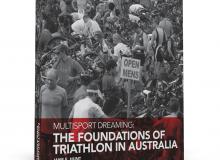
Multisport Dreaming: The Foundations of Triathlon in Australia is a book just out (Write Press, QLD, AUS 2014) from Dr. Jane E. Hunt, an Assistant Professor at Bond University in Australia. But it's not just another entry into the crowded "multisport" category. Hunt has penned an historical work of some significance; a highly-researched and crisply-written chronicle of the rich events, faces, episodes, and politics that shaped triathlon in Australia. Dr. Hunt's exhaustive work will be chronicled in detail in a future TriHistory.com entry but we suggest for now that her tenacious efforts of getting the past right signal a shift in how our global sport is increasingly being approached and explored from a perspective well beyond wattage output and a coach-of-the-month milieu.
Australia's contributions to the growth and maturation of triathlon are immutable. And its colorful characters from Curl Curl's Marc Dragan to our indomitable imp, Greg Welch, to 2012 Ironman World Champion, Pete Jacobs, are just part of Hunt's detailed romp through one country's triathlon history. Limited first printing certain to sell out. Read more HERE -- ST
National Distance Running HOF Will Induct Three in July
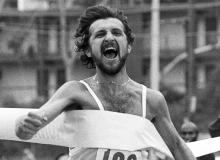
An exultant Tom Flemming crosses the finish line of the Jordache Marathon in Los Angeles in March 1981. The race was a precursor to the current LA Marathon, and Flemming had a day that most runners only dream about -- floating almost efforlessly for 26.2 miles and winning the race with second place far out of sight behind him. Mike Plant photo
It's not triathlon per se, but we thought that since runners launched the sport in the first place, we should at least announce that National Distance Running Hall of Fame will induct its 12th class on July 12 at Mohawk Valley Community College in Utica, New York.
The three inductees are marathoner Tom Fleming, cross country great Fred Wilt and pioneering female marathoner, Kim Merritt. Read press release HERE
USAT Hall of Fame Induction Banquet in Chicago
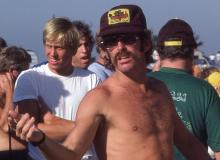
Tom Warren in charge at his Tug's Tavern Run-Swim-Run event in Sept., 1979. Seven months previously, Warren had won the second "Iron Man" in Hawaii, and while his Tug's race has a place in multi-sport history, no one could have foreseen the impact of his victory in Hawaii. Mike Plant photo
The 2014 USA Triathlon Hall of Fame induction ceremony is set for Thursday, June 26 at the Navy Pier Ballroom in Chicago. As previously reported here, Five individuals will be honored as the sixth induction class to the Hall (No physical "hall" yet exists, but surely that's only a matter of time): Ironman founders John & Judy Collins; Tom Warren, winner of the 1979 "Iron Man"; former pro great and serial national champ Mike Pigg; and age-grouper Sister Madonna Buder, the so-called "The Iron Nun".
For more information see the USAT press release HERE
College Spirit in Tempe
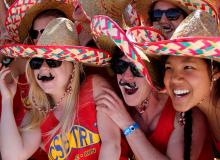
The triathletes at the USAT National Collegiate Championships in Tempe, Ariz. last April were well... triathletes. It was the team spirit and spirited inter-school competition that turned a good event into a great one. The supporters from UC San Barbara put both feet in the effort -- and then some.
USAT National Collegiate National Championship
It may seem a little odd to be talking in a historical context about the 2014 USAT National Collegiate Championships held this year on April 4-5 in Tempe, AZ. But honestly, the event was a revelation – the embodiment of what the early visionaries in this sport had mind. Or was it actually beyond what they had in mind because such a thing was pretty much impossible to even contemplate 3o years ago?
The ascension of triathlon to the Olympic stage was an exercise of patience and political mastery. No doubt in some near future we will write on these pages the story of Carl Thomas, Les McDonald and How the Olympic Triathlon Came to Be. But there was nothing political about the collegiate competition in display in Tempe in April. I'm not sure how better to put it than joy. Folks were racing hard, yes, but they were also having a heckuva lot of fun. Triathlon is not yet a varsity sport with the NCAA universe, but if anything, its current club status seems to add rather than subtract. Under the tents that bore names of more than 40 U.S colleges and universities, from West Point to USC to Texas A & M, from Cal/Berkeley to Colorado to Georgia, were triathletes of every possible level of experience and skill. There were parents on hand to cheer, and rowdy groups of students on hand to cheer louder and harder. There were team chants and team tactics. The multisport lifestyle in the context of college club competition seemed neither intense nor all-consuming. It was loud, enthusiastic, and inclusive. Most of all, it was engaging. What a way to build a sport, I thought. What a way to build a national program. – MP


